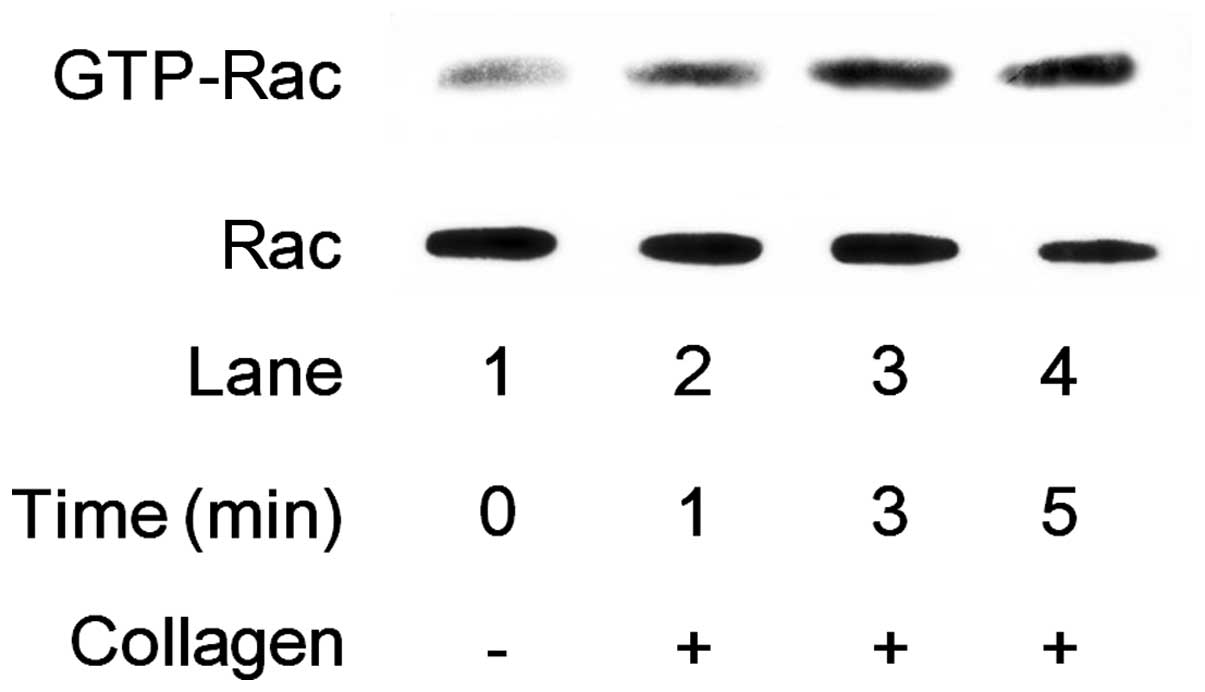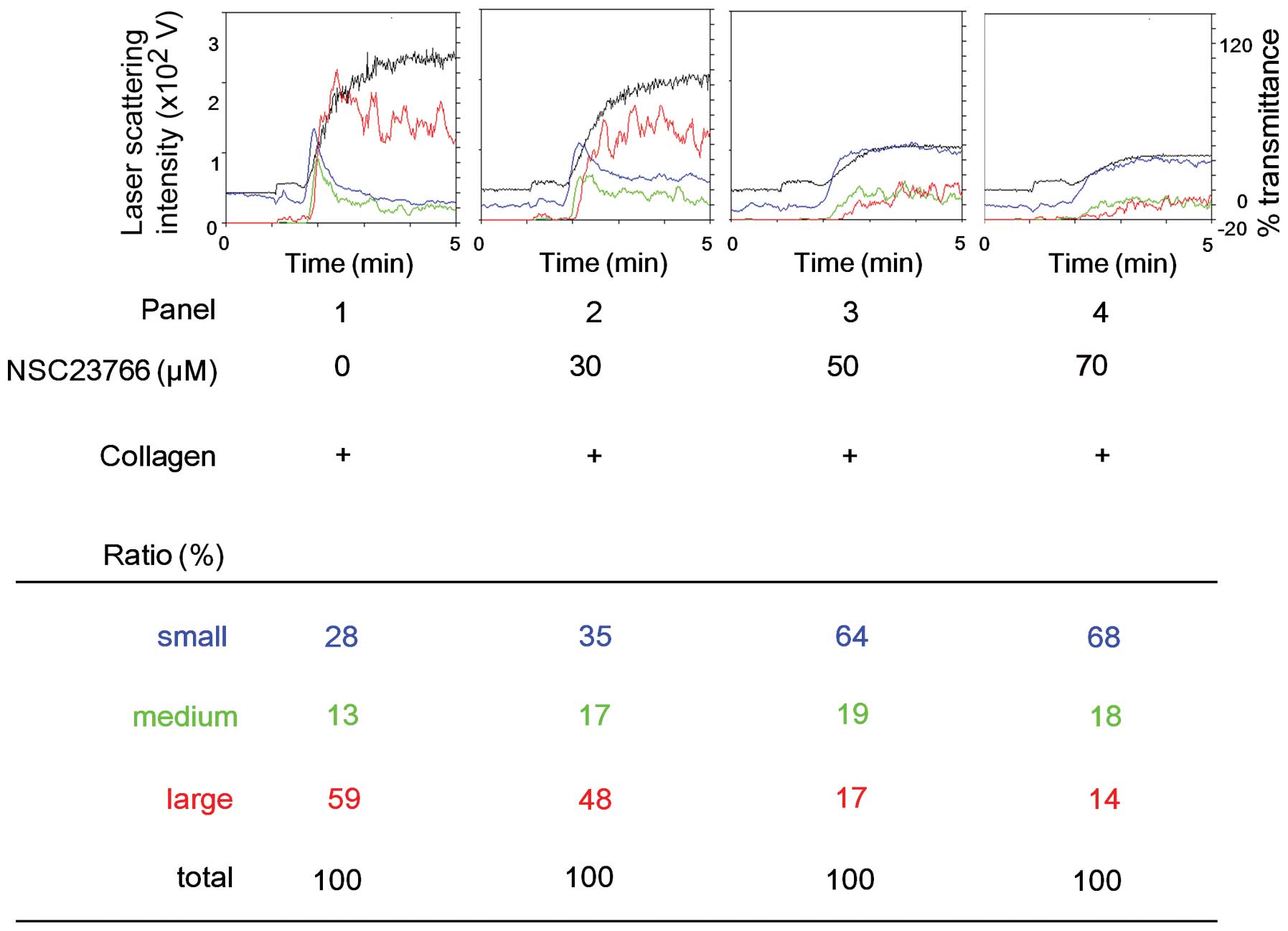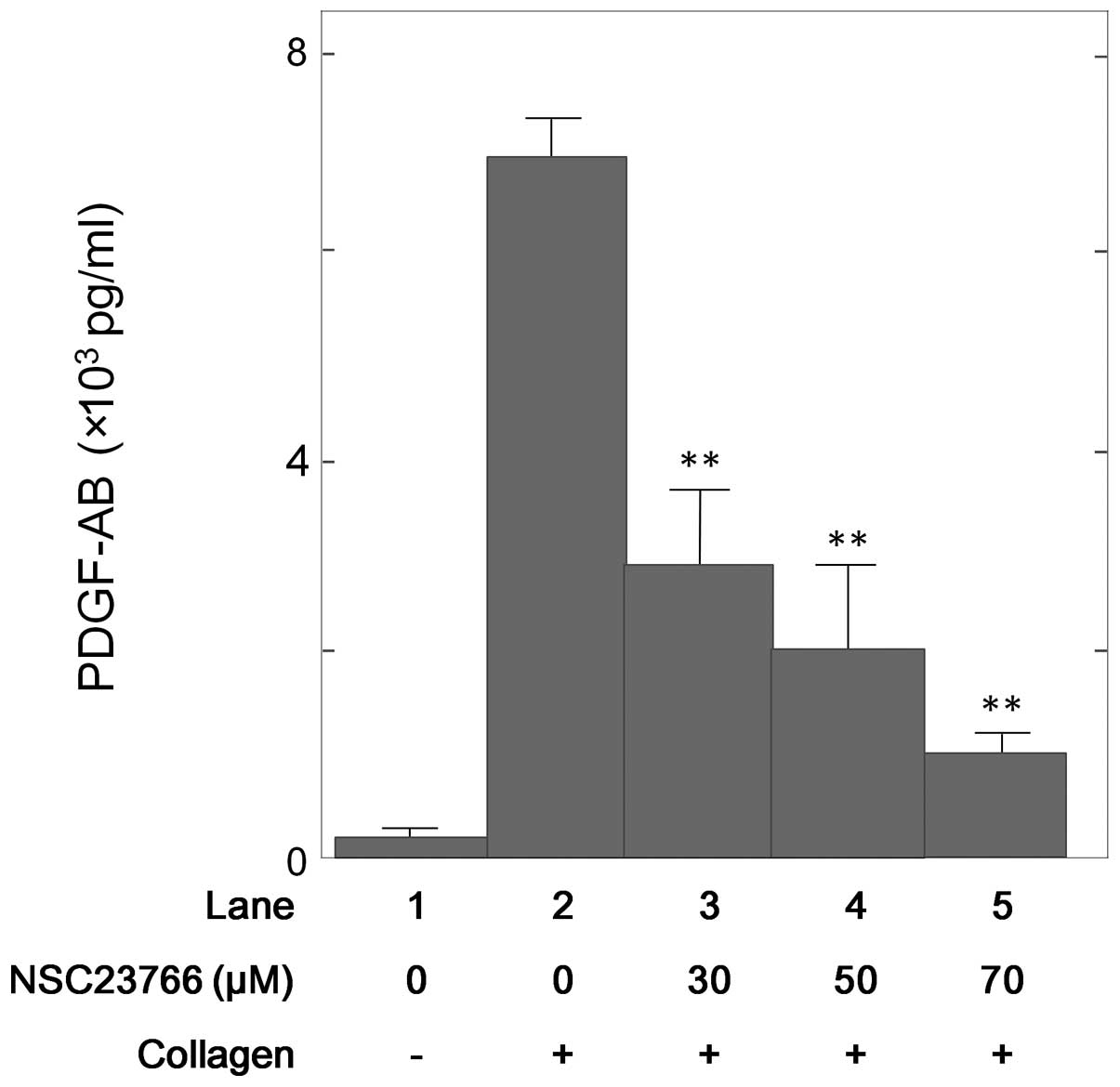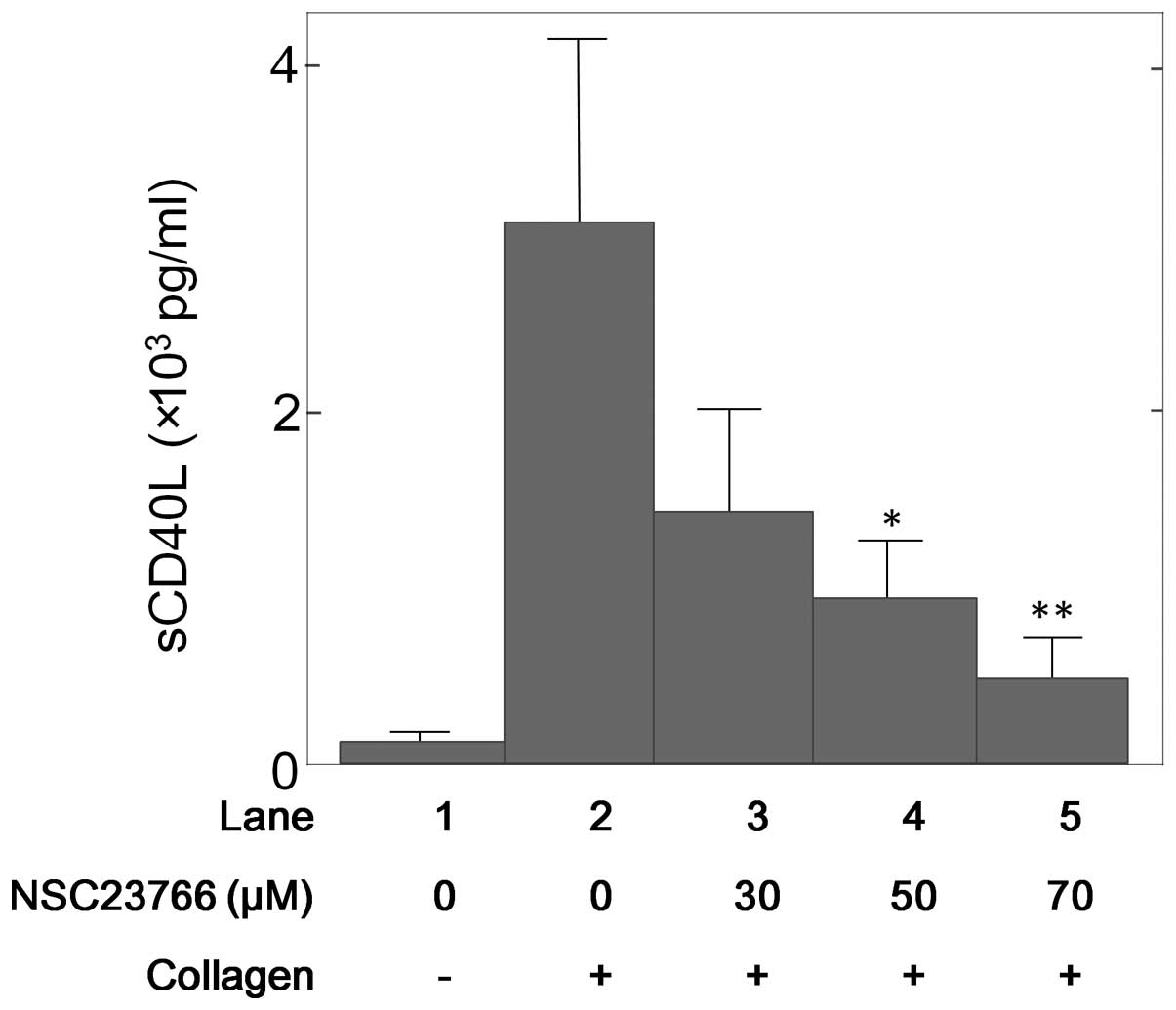Rac regulates collagen-induced HSP27 phosphorylation via p44/p42 MAP kinase in human platelets
- Authors:
- Published online on: July 23, 2013 https://doi.org/10.3892/ijmm.2013.1455
- Pages: 813-818
Abstract
Introduction
Platelet activation and aggregation represent the first step in thrombus formation at an injured vascular site and play a crucial role in hemostasis. Platelets are activated by various stimuli, resulting in shape change, adhesion, aggregation and subsequently, thrombus formation. Thrombus formation is associated with the release of granule contents, such as platelet-derived growth factor (PDGF)-AB and serotonin and the release of inflammatory substances, such as soluble CD40 ligand (sCD40L). These secreted and generated mediators trigger a positive feedback mechanism that potentiates platelet activation (1,2).
The expression of heat shock proteins (HSPs) is induced in a variety of cells in response to various types of biological stress, such as heat and chemical stress (3). It is generally recognized that HSPs can act as molecular chaperones, which prevent the aggregation of unfolded proteins and have cytoprotective functions under certain stressful conditions. HSP27 (HSPB1) is a member of the low-molecular-weight HSP family (HSPB) with molecular masses ranging from 15–30 kDa (3,4). It is firmly established that HSP27 activity is regulated by post-translational modifications, such as phosphorylation (3,4). HSP27 is promptly phosphorylated in response to various types of stress, as well as following exposure to cytokines and mitogens and changes from an aggregated form (up to 800 kDa) to a dissociated form (3,4). Human HSP27 is phosphorylated at three serine residues (Ser-15, Ser-78 and Ser-82). It is recognized that the phosphorylation of HSP27 is catalyzed by members of the mitogen-activated protein (MAP) kinase superfamily, such as p38 MAP kinase (3,4). However, the precise roles of phosphorylated HSP27 have not yet been clarified.
Collagen is known to be one of the most important physiological stimuli for human platelet activation and its receptors on the platelet membranes are classified into two main groups, glycoprotein (GP)VI and integrin-α2β1 (5). The firm adhesion of activated integrin-α2β1 by binding to collagen and the strengthening of GPVI-collagen interactions lead to integrated signaling and further upregulation of integrin activities, thus resulting in the enhancement of granule secretion and the development of coagulant activity (6–8). It has been reported that p38 MAP kinase is activated by collagen and regulates the phosphorylation of HSP27, which is likely to be necessary for human platelet activation (9). We have previously demonstrated that the collagen-induced phosphorylation of HSP27 via p44/p42 MAP kinase is sufficient for the release of PDGF-AB and sCD40L from human platelets (10). However, the exact role of collagen in platelet activation remains to be elucidated.
Rac is a member of the Rho family of small GTPases (11). It is well recognized that the Rho family regulates cytoskeletal reorganization and gene expression. Rac is inactive when bound to GDP and is activated upon the exchange of GDP for GTP, which leads to downstream signaling. As regards Rac in platelets, it has been shown that platelets express the Rho family, including Rac (12). In addition, collagen and thrombin reportedly stimulate the activation of Rac, which is critical for thrombus formation (12,13). However, the exact role of Rac in human platelets has not yet been clarified. In the present study, we investigated the involvement of Rac in the collagen-induced release of PDGF-AB and sCD40L in human platelets. We demonstrate that Rac regulates the collagen-induced HSP27 phosphorylation via p44/p42 MAP kinase in human platelets, resulting in the stimulation of PDGF-AB secretion and the release of sCD40L.
Materials and methods
Materials
Collagen was purchased from Nycomed Pharma GmbH (Munich, Germany). NSC23766 was purchased from Tocris Bioscience (Bristol, UK). Phospho-p44/p42 MAP kinase antibodies and p44/p42 MAP kinase antibodies were from Cell Signaling Technology, Inc. (Beverly, MA, USA). Phospho-HSP27 (Ser-15) antibodies, phospho-HSP27 (Ser-78) antibodies and HSP27 antibodies were from Stressgen Biotechnologies (Victoria, BC, Canada). Phospho-HSP27 (Ser-82) antibodies were from Biomol Research Laboratories (Plymouth Meeting, PA, USA). GAPDH antibodies were purchased from Santa Cruz Biotechnology, Inc. (Santa Cruz Biotechnology, Inc., CA, USA). The ECL Western blotting detection system was purchased from GE Healthcare (Little Chalfont, UK). Other materials and chemicals were obtained from commercial sources.
Preparation of platelets
Human blood was donated from healthy volunteers into a 1/10 volume of 3.8% sodium citrate. Platelet-rich plasma (PRP) was obtained from blood samples by centrifugation at 155 × g for 12 min at room temperature. Platelet-poor plasma was prepared from the residual blood by centrifugation at 2,500 × g for 5 min. All participants signed an informed consent agreement after receiving a detailed explanation of the study. This study was approved by the Ethics Committee of Gifu University Graduate School of Medicine. Gifu, Japan.
Measurement of platelet aggregation induced by collagen
Platelet aggregation using citrated PRP was carried out in a PA-200 aggregometer (Kowa Co., Ltd., Tokyo, Japan), which can determine the size of platelet aggregates based upon the particle count using a laser scattering method (small size, 9–25 μm; medium size, 25–50 μm; large size, 50–70 μm) (14) at 37°C for 5 min with a stirring speed of 800 rpm. The percentage of transmittance of the isolated platelets was recorded as 0% and that of the appropriate platelet-poor plasma (blank) was recorded as 100%. When indicated, PRP was pre-treated with NSC23766 for 15 min.
Protein preparation following stimulation with collagen
Following stimulation with 1.0 μg/ml collagen for 5 min (for measurement of the protein expression levels by western blot analysis) and for 30 min (for measurement of the levels of PDGF-AB and sCD40L), the platelet aggregation was terminated by the addition of an ice-cold EDTA (10 mM) solution, followed by centrifugation at 10,000 × g at 4°C for 2 min. To perform western blot analysis, the pellet was washed twice with phosphate-buffered saline and then lysed and immediately boiled using a lysis buffer containing 62.5 mM Tris/Cl, pH 6.8, 2% sodium dodecyl sulfate (SDS), 50 mM dithiothreitol and 10% glycerol as previously described (15). To measure PDGF-AB and sCD40L as described below, the supernatant was isolated and stored at −20°C for subsequent ELISA.
Western blot analysis
Western blot analysis was performed as previously described (15). Briefly, SDS-polyacrylamide gel electrophoresis (PAGE) was performed using the Laemmli method (16) on a 12% or 10% polyacrylamide gel. Proteins were fractionated and transferred onto Immnobilion-P membranes (PVDF). The membranes were blocked with 5% fat-free dry milk in Tris-Buffered saline with 0.1% Tween-20 (TBS-T, 20 mM Tris, pH 7.6, 137 mM NaCl, 0.1% Tween-20) for 1 h before incubating them with the indicated primary antibodies. Phospho-p44/p42 MAP kinase antibodies, p44/p42 MAP kinase antibodies, phospho-HSP27 (Ser-15) antibodies, phospho-HSP27 (Ser-78) antibodies and phospho-HSP27 (Ser-82) antibodies and HSP-27 antibodies were used as primary antibodies. Peroxidase-labeled anti-mouse IgG (Santa Cruz Biotechnology, Inc.) or anti-rabbit IgG antibodies (KPL, Gaithersburg, MD, USA) were used as secondary antibodies. The primary and secondary antibodies were diluted to the optimum concentrations with 5% fat-free dry milk in PBS-T (phosphate-buffered saline with 0.1% Tween-20). The peroxidase activity on PVDF membranes was visualized on X-ray films by means of an ECL western blotting detection system (GE Healthcare) as described in the manufacturer’s instruction manual.
Measurement of Rac activity
Following stimulation with 1.0 μg/ml collagen for 0, 1, 3 or 5 min, platelet aggregation was terminated by the addition of an ice-cold EDTA (10 mM) solution, followed by centrifugation at 10,000 × g at 4°C for 2 min. The pellet was washed twice with ice-cold Tris-buffered saline and Rac1 activity was determined using the Rac1 Activation Assay kit (Millipore Corp., Temecula, CA, USA) as described in the manufacturer’s instruction manual.
Measurement of plasma PDGF-AB and sCD40L levels
The plasma PDGF-AB and sCD40L levels in the human samples were determined using PDGF-AB Quantikine ELISA and sCD40-Ligand Quantikine ELISA kits, respectively, purchased from R&D systems, Inc. (Minneapolis, MN, USA). All assay procedures were performed according to the manufacturer’s instructions.
Determination
Densitometric analysis was performed using Molecular Analyst/Macintosh (Bio-Rad Laboratories, Hercules, CA, USA).
Statistical analysis
All figures shown are from representative results of five independent experiments. The data are presented as the means ± SEM. The data were analyzed by the Student’s t-test and a p-value <0.05 was considered to indicate a statistically significant difference.
Results
Effect of Rac on collagen-stimulated human platelets
It has been demonstrated that Rac1 is involved in collagen-induced platelet aggregation (12). Thus, in this study, we first examined whether collagen stimulates the activation of Rac in human platelets. Collagen (1.0 μg/ml) markedly increased the GTP-Rac levels in human platelets in a time-dependent manner (Fig. 1).
Effect of NSC23766 on platelet aggregation induced by collagen stimulation
We then examined the effect of NSC23766, a selective inhibitor of Rac1-guanine nucleotide exchange factor (GEF) interaction (17), on the platelet aggregation stimulated by collagen using an aggregometer with laser scattering methods. NSC23766 markedly suppressed the collagen-induced platelet aggregation in a dose-dependent manner in the range between 30–70 μM (Fig. 2). According to an analysis of the size of the platelet aggregates, the number of large aggregates (50–70 μm) decreased in a dose-dependent manner following treatment with NSC23766. On the other hand, NSC23766 markedly increased the number of small aggregates (9–25 μm) (Fig. 2).
Effects of NSC23766 on the collagen-induced phosphorylation of p44/p42 MAP kinase and HSP27
In our previous study (10), we reported that the phosphorylation of HSP27 via p44/p42 MAP kinase activation is involved in the collagen-induced release of PDGF-AB and sCD40L from human platelets. Therefore, in this study, we examined the effects of NSC23766 on the collagen-induced phosphorylation of p44/p42 MAP kinase and HSP27 in human platelets. NSC23766 markedly attenuated the collagen-induced phosphorylation of p44/p42 MAP kinase in a dose-dependent manner in the range between 30–70 μM (Fig. 3). In addition, NSC23766 significantly suppressed the collagen-induced phosphorylation of HSP27 at three serine residues (Ser-15, Ser-78 and Ser-82) in human platelets (Fig. 4).
Effect of NSC23766 on the collagen-induced platelet granule secretion
To evaluate whether NSC23766 affects the collagen-induced platelet granule secretion, we then examined its effect on the collagen-induced secretion of PDGF-AB from human platelets. NSC23766 significantly suppressed the collagen-induced PDGF-AB secretion from human platelets in a dose-dependent manner in the range between 30–70 μM (Fig. 5).
Effect of NSC23766 on the collagen-induced release of sCD40L from human platelets
Additionally, we examined the effect of NSC23766 on the collagen-stimulated sCD40L release from human platelets. NSC23766 significantly reduced the collagen-stimulated release of sCD40L (Fig. 6) and this inhibitory effect of NSC23766 was dose-dependent in the range between 30–70 μM.
Discussion
In the present study, we investigated the exact role of Rac in the collagen-stimulated activation of human platelets, paying particular attention to the association between Rac and HSP27 phosphorylation. It has been reported that collagen stimulates Rac GTPase activation in human platelets and that Rac is essential for thrombus formation (12,13). We found that collagen markedly increased the levels of GTP-Rac in human platelets in a time-dependent manner. In addition, NSC23766, which is a selective inhibitor of Rac1-GEF interaction (17), inhibited the collagen-induced platelet aggregation. According to the size of the platelet aggregates using a laser scattering method, the ratio of large platelet aggregates (50–70 μm) decreased in a dose-dependent manner following treatment with NSC23766, while the ratio of small platelet aggregates (9–25 μm) markedly increased. In a previous study (10), we demonstrated that collagen induces the phosphorylation of HSP27 via p44/p42 MAP kinase in human platelets, resulting in the stimulation of PDGF-AB secretion and the release of sCD40L. Therefore, in this study, we investigated the involvement of Rac in the collagen-stimulated release of PDGF-AB and sCD40L through HSP27 phosphorylation in human platelets. NSC23766 markedly suppressed the collagen-induced phosphorylation of p44/p42 MAP kinase and HSP27 at three residues (Ser-15, Ser-78 and Ser-82). We also demonstrated that the collagen-induced granule secretion of PDGF-AB was significantly decreased by pre-treatment with NSC23766. In addition, NSC23766 attenuated the release of sCD40L stimulated by collagen. Taking our findings into account as a whole, it is most likely that Rac activated by collagen functions at a point upstream from p44/p42 MAP kinase and regulates the phosphorylation of HSP27 in human platelets, resulting in the stimulation of PDGF-AB secretion and the release of sCD40L.
Collagen is a major component of the extracellular matrix and plays a central role in the hemostatic cascade at sites of vascular injury (9,18). It is firmly established that the materials stored in specific granules, such as dense granules and α-granules are secreted from activated platelets. Dense granules contain small non-protein molecules, including adenosine diphosphate (ADP) and 5-hydroxytryptamine. On the other hand, α-granules contain large adhesive and healing proteins, such as PDGF-AB and P-selectin (19). PDGF-AB released from platelet α-granules is a potent mitogenic growth factor, which mainly acts on connective tissue, such as vascular smooth muscle cells and promotes atherosclerosis (20). In addition, activated platelets release inflammatory mediators of atherosclerosis, such as CD40L. CD40L is stored in the cytoplasm of unstimulated platelets and rapidly translocates to the surface following platelet activation by agonists, such as collagen (21,22). CD40L expressed on the activated platelet surface undergoes a cleavage that generates a functional soluble fragment, termed sCD40L. It is recognized that the release of sCD40L from platelets induces inflammatory responses via CD40, which is expressed on vascular endothelial cells and neurtrophils (23). The elevation of plasma sCD40L is reportedly associated with an increased risk of cardiovascular events in patients with unstable coronary artery disease (24). In the present study, we found that the collagen-induced secretion of PDGF-AB from α-granules and the release of sCD40L were significantly inhibited by pre-treatment with NSC23766. Based on these findings, it seems likely that Rac stimulated by collagen in human platelets may affect atherosclerosis and inflammation by regulating the levels of PDGF-AB and the release of sCD40L and that the effect of Rac on platelets is due to HSP27 phosphorylation via p44/p42 MAP kinase.
In conclusion, our results strongly suggest that Rac regulates collagen-induced HSP27 phosphorylation via p44/p42 MAP kinase in human platelets, resulting in the stimulation of PDGF-AB secretion and the release of sCD40L.
Acknowledgements
We are very grateful to Yumiko Kurokawa for her skillful technical assistance. This study was supported in part by a Grant-in-Aid for Scientific Research (nos. 20590565 and 20591825) from the Ministry of Education, Science, Sports and Culture of Japan and a Research Grant for Longevity Sciences (22-4) from the National Center for Geriatrics and Gerontology, Japan.
References
|
Kahner BN, Shankar H, Murugappan S, Prasad GL and Kunapuli SP: Nucleotide receptor signaling in platelets. J Thromb Haemost. 4:2317–2326. 2006. View Article : Google Scholar : PubMed/NCBI | |
|
Li Z, Delaney MK, O’Brien KA and Du X: Signaling during platelet adhesion and activation. Arterioscler Thromb Vasc Biol. 30:2341–2349. 2010. View Article : Google Scholar : PubMed/NCBI | |
|
Benjamin IJ and McMillan DR: Stress (heat shock) proteins molecular chaperones in cardiovascular biology and disease. Circ Res. 83:117–132. 1998. View Article : Google Scholar : PubMed/NCBI | |
|
Mymrikov EV, Seit-Nebi AS and Gusev NB: Large potentials od small heat shock proteins. Physiol Rev. 91:1123–1159. 2011. View Article : Google Scholar : PubMed/NCBI | |
|
Kahn ML: Platelet-collagen responses: molecular basis and therapeutic promise. Semin Thromb Hemost. 30:419–425. 2004. View Article : Google Scholar : PubMed/NCBI | |
|
Shattil SJ and Newman PJ: Integrins: dynamic scaffolds for adhesion and signaling in platelets. Blood. 104:1606–1615. 2004. View Article : Google Scholar : PubMed/NCBI | |
|
Nieswandt B and Watson SP: Platelet-collagen interaction: is GPVI the central receptor? Blood. 102:449–461. 2003. View Article : Google Scholar : PubMed/NCBI | |
|
Moroi M and Jung SM: Platelet grycoprotein VI: its structure and function. Thromb Res. 114:221–233. 2004. View Article : Google Scholar : PubMed/NCBI | |
|
Saklatvala J, Rawlinson L, Waller RJ, Sarsfield S, Lee JC, Morton LF, Barnes MJ and Farndale RW: Role for p38 mitogen-activated protein kinase in platelet aggregation caused by collagen or a thromboxane analogue. J Biol Chem. 271:6586–6589. 1996. View Article : Google Scholar : PubMed/NCBI | |
|
Kato H, Adachi S, Doi T, Matsushima-Nishiwaki R, Minamitani C, Akamatsu S, Enomoto Y, Tokuda H, Otsuka T, Iwama T, Kozawa O and Ogura S: Mechanism of collagen-induced release of 5-HT, PDGF-AB and sCD40L from human platelets: role of HSP27 phosphorylation via p44/p42 MAPK. Thromb Res. 126:39–43. 2010. View Article : Google Scholar : PubMed/NCBI | |
|
Takai Y, Sasaki T and Matozaki T: Small GTP-binding proteins. Physiol Rev. 81:153–208. 2001.PubMed/NCBI | |
|
Pleines I, Elvers M, Strehl A, Pozgajova M, Varga-Szabo D, May F, Chrostek-Grashoff A, Brakebusch C and Nieswandt B: Rac1 is essential for phospholipase C-γ2 activation in platelets. Pflugers Arch. 457:1173–1185. 2009. | |
|
Soulet C, Gendreau S, Missy K, Benard V, Plantavid M and Payrastre B: Characterisation of Rac activation in thrombin-and collagen-stimulated human blood platelets. FEBS Lett. 507:253–258. 2001. View Article : Google Scholar : PubMed/NCBI | |
|
Tohgi H, Takahashi H, Watanabe K, Kuki H and Shirasawa Y: Development of large platelet aggregates from small aggregates as determined by laser-light scattering: effects of aggregant concentration and antiplatelet medication. Thromb Haemost. 75:838–843. 1996. | |
|
Kato K, Ito H, Hasegawa K, Inaguma Y, Kozawa O and Asano T: Modulation of the stress-induced synthesis of hsp27 and αB-crystallin by cyclic AMP in C6 rat glioma cells. J Neurochem. 66:946–950. 1996. | |
|
Laemmli UK: Cleavage of structural proteins during the assembly of the head of bacteriophage T4. Nature. 227:680–685. 1970. View Article : Google Scholar : PubMed/NCBI | |
|
Gao Y, Dickerson JB, Guo F, Zheng J and Zheng Y: Rational design and characterization of a Rac GTPase-specific small molecule inhitor. Proc Natl Acad Sci USA. 101:7618–7623. 2004. View Article : Google Scholar : PubMed/NCBI | |
|
Davi G and Patrono C: Platelet activation and atherothrombosis. N Engl J Med. 357:2482–2494. 2007. View Article : Google Scholar : PubMed/NCBI | |
|
Rendu F and Brohard-Bohn B: The platelet release reaction: granules’ constituents, secretion and functions. Platelets. 12:261–273. 2001. | |
|
Heldin CH and Westermark B: Mechanism of action and in vivo role of platelet-derived growth factor. Physiol Rev. 79:1283–1316. 1999.PubMed/NCBI | |
|
Hermann A, Rauch BH, Braun M, Schror K and Weber AA: Platelet CD40 ligand (CD40L)-subcellular localization, regulation of expression, and inhibition by clopidogrel. Platelets. 12:74–82. 2001. View Article : Google Scholar : PubMed/NCBI | |
|
Andre P, Nannizzi-Alaimo L, Prasad SK and Phillips DR: Platelet-derived CD40L: the switch-hitting player of cardiovascular disease. Circulation. 106:896–899. 2002. View Article : Google Scholar : PubMed/NCBI | |
|
Henn V, Slupsky JR, Grafe M, Anagnostopoulos I, Forster R, Muller-Berghaus G and Kroczek RA: CD40 ligand on activated platelets triggers an inflammatory reaction of endothelial cells. Nature. 391:591–594. 1998. View Article : Google Scholar : PubMed/NCBI | |
|
Heeschen C, Dimmeler S, Hamm CW, van den Brand MJ, Boersma E, Zeiher AM and Simoons ML; CAPTURE Study Investigators. Soluble CD40 ligand in acute coronary syndromes. N Engl J Med. 348:1104–1111. 2003. View Article : Google Scholar : PubMed/NCBI |















